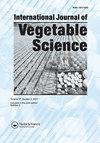农业废弃物栽培平菇及其对子实体营养成分的影响
Q2 Agricultural and Biological Sciences
引用次数: 0
摘要
摘要:人们对栽培平菇对农业废弃物的影响及其对子实体营养价值和生物效率的影响的研究很少。以干燥的形式收集油棕纤维、稻壳、硬木锯末、麦地那草、豆荚和稻草,并用作基质。利用平菇活性菌丝体制备菌种,30天后观察其生长情况 接种后第天,收获子实体进行分析。粗蛋白质、粗脂肪、粗纤维、灰分、水分、干物质和碳水化合物组成的近似组成;黄酮类化合物、苯酚、番茄红素、β-胡萝卜素和抗坏血酸的抗氧化特性以及Na、K、Ca、Mg、Cu、Mn和Zn的组成因底物而异。基质上栽培的平菇含有大量的粗蛋白质、粗脂肪、粗纤维、灰分、水分、干物质和碳水化合物、类黄酮、苯酚、番茄红素、β-胡萝卜素和抗坏血酸,以及Na、K、P、N和Ca等矿物质离子。在所用基质上生长的平菇含有大量营养物质。稻草和豆荚可用于实现平菇的高营养成分和抗氧化剂含量。本文章由计算机程序翻译,如有差异,请以英文原文为准。
Cultivation of Pleurotus ostreatus on agricultural wastes and effects on nutritional composition of the fruiting body
ABSTRACT Little interest has been shown in studies related to the effects of cultivating Pleurotus ostreatus on agricultural wastes and their impacts on nutritional value and biological efficiency of the fruiting body. Oil palm fiber, rice husk, sawdust from hardwood, guinea grass, bean pods and rice straw were collected in dried form and used as substrates. Active mycelium of P. ostreatus was used in preparation of spawn, and growth was observed after 30 days following inoculation and fruiting bodies were harvested for analysis. The proximate composition of crude protein, crude fat, crude fiber, ash, moisture, dry matter and carbohydrate composition; antioxidant properties from flavonoids, phenol, lycopene, beta carotene, and ascorbic acid and composition of Na, K, Ca, Mg, Cu, Mn and Zn varied across substrates. All cultivated P. ostreatus on substrates contained high amounts of crude protein, crude fat, crude fiber, ash, moisture, dry matter and carbohydrate, flavonoid, phenol, lycopene, beta carotene, and ascorbic acid, and mineral ions such as Na, K, P, N and Ca. Dry weight and biological efficiency were highest in P. ostreatus cultivated on rice straw, followed by bean pods. Pleurotus ostreatus grown on substrates used contained high amounts of nutrients. Rice straw and bean pods may be used to achieve high nutritional composition and antioxidant contents in P. ostreatus mushrooms.
求助全文
通过发布文献求助,成功后即可免费获取论文全文。
去求助
来源期刊

International Journal of Vegetable Science
Agricultural and Biological Sciences-Plant Science
CiteScore
3.10
自引率
0.00%
发文量
30
期刊介绍:
The International Journal of Vegetable Science features innovative articles on all aspects of vegetable production, including growth regulation, pest management, sustainable production, harvesting, handling, storage, shipping, and final consumption. Researchers, practitioners, and academics present current findings on new crops and protected culture as well as traditional crops, examine marketing trends in the commercial vegetable industry, and address vital issues of concern to breeders, production managers, and processors working in all continents where vegetables are grown.
 求助内容:
求助内容: 应助结果提醒方式:
应助结果提醒方式:


